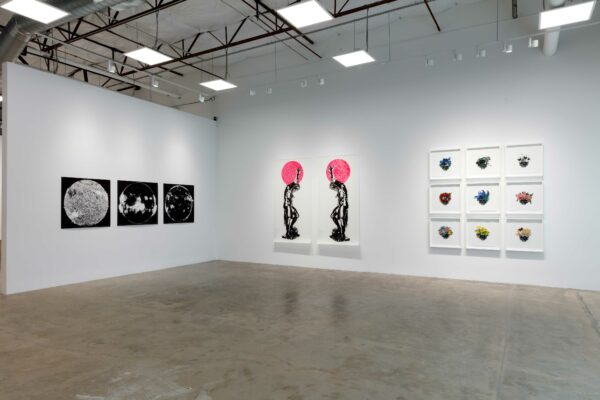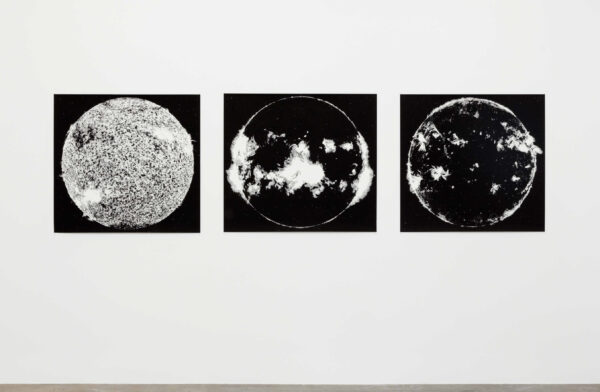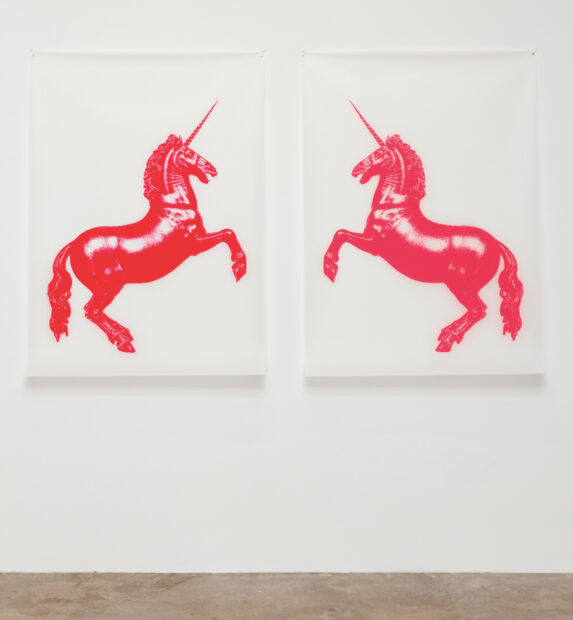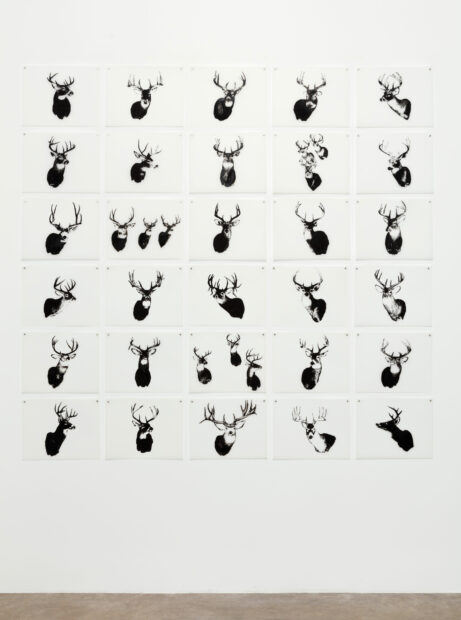
Installation view of René Treviño, “Flare” at Erin Cluley Gallery. Photo: Kevin Todora, courtesy of the artist and Erin Cluley Gallery.
Flare, René Treviño’s fourth solo show at Erin Cluley Gallery in Dallas, features hand-painted artworks tackling historical narratives and their intersection with identity. Blending appropriated imagery from the Western art historical canon with imagery specific to his own identity as a gay Mexican-American man, Flare invites visitors to reimagine history and our connection to it in the present. I met with René Treviño to preview the exhibition and hear more about the artworks on view.
Megan Wilson Krznarich (MK): I want to start off talking about the title of the exhibition, Flare. How did you land on that? What is its meaning to you?
René Treviño (RT): I made these Solar Flare pieces a year or two ago, so that is part of it. But I also like that flare is a homonym; it is two words that sound the same, but are spelled differently. There is flare and there is also flair. I loved that it could be both of those things. It is the literal solar flares, but then it also has that flair. You know, I like to throw a rhinestone down, I like hot pink, I like some lace and appliqué.

Installation view of René Treviño, “Solar Flare II,” “Solar Flare III,” and “Solar Flare I,” 2021, acrylic and rhinestones on Dura-Lar. Photo: Kevin Todora, courtesy of the artist and Erin Cluley Gallery.
MK: What sparked your interest in solar flares to begin with?
RT: A lot of my paintings end up being these circular forms inside of squares. We are on this giant sphere, we look up and the sun lights us, the moon guides our way at night, and then there are the stars. All of these are spheres. So, the sphere shape feels really important to me. Also, I love images of space. To me, space is so optimistic, and looking up is the ultimate act of optimism because we have done some damage here on Earth. So, I like to look up at space and think about the places we have not messed up yet.
I think the solar flares are beautiful. They are so powerful, with the kind of heat that we cannot even imagine. The solar flares in the works came from still images, but with the rhinestones you can imagine these forms moving, and they provide a certain kind of flicker. Depending on where you stand you get a different kind of sparkle, until it starts to move the artwork a little bit like the surface of the sun, which is always moving. And I just love a rhinestone.
MK: Yes, there is a play on light that provides a kind of dynamism. I also think the idea of space as optimistic is interesting. There is a sense of space possibly being our future because of the damage we have done to this planet. Your work has a strong sense of looking to the future, but so much of it also engages with history.
RT: I like that dichotomy. I love history. I like to learn about the things that happened before and lessons learned that help us move forward in a new way. But I also like to think about the future too, because we are always right in between the past and the future.
MK: That is an interesting thought, because there is so much to be written and rewritten for both the past and the future. There’s re-imagining histories that have been told from certain perspectives, but we’re also still writing the future and we need to make sure to incorporate multiple perspectives as we do.

Installation view of René Treviño, “Weight of Art History (after Tacca and DaVinci),” and “Weight of Art History (after Tacca and Mexica),” 2022, acrylic on Dura-Lar. Photo: Kevin Todora, courtesy of the artist and Erin Cluley Gallery.
RT: That is exactly it. History is one of those things where you always have to be mindful of who is telling the story, because very often it is the people who won, or the people who were victorious that get to dictate how history is remembered. You always have to find alternative ways to research and get a more holistic picture of what actually happened. Also, I love heroes, or the idea of heroism. But when you think of someone who is a hero, they are someone else’s villain. It is always really complicated.
For example, Hercules is a hero we love. I loved reading those Hercules stories when I was a kid, about all the different trials he had to go through. But then you think, well wait, what did that three-headed dog do to him, or to anyone? We root for Hercules, but to someone else Hercules is not the hero, which I think is the case with just about any hero. They are doing really amazing, wonderful things, but you can also see the flip side of that.
MK: Can you share more about the Hercules works in the show?
RT: They are about the weight, the burden in the moment in the trials when Hercules takes the heavens from Atlas. So here is Hercules, half-man and half-God, holding the heavens. This is a painting from an Italian Renaissance bronze, and in the original sculpture there is a sphere covered with zodiac symbols. I took those Zodiac symbols out. The first version I made has the Aztec calendar, which is a powerful symbol that you kind of see everywhere. I have seen the actual Mexica calendar stone in Mexico City at the National Anthropology Museum, and it is such a beautiful, powerful object. I thought it would be interesting to weigh Hercules down with the weight of Mexican oppression, the way Mexican people have been oppressed historically.
Originally, I thought the second version would be the same, just the reverse of the Aztec calendar stone version, but then I saw this knot by Leonardo da Vinci, which I found through a series of knot paintings by Albrecht Dürer. I didn’t realize that Dürer was looking at da Vinci, who made a whole series of his own knots. I thought it was interesting that Dürer was appropriating; we like to think appropriation is this brand-new thing, a contemporary idea, but in fact it has been going on for a really long time.
I also thought it was interesting to place da Vinci on top of Hercules. Da Vinci is often the person you learn about the most in art history texts, and I thought it was interesting for Hercules to bear the weight of this history, because how we learn about art history is complicated. When I was first learning art history at Texas A&M, the classes were great, but really centered on Western art history. If you want to get outside of that Western canon, you have to go out and do that research independently. I think it is getting better, but I really like the idea of Hercules being weighed down by that weight.
MK: Yes, I found it really intriguing when I first walked into the gallery and saw this blending of images that we are accustomed to seeing from the traditional Western canon with Mesoamerican, and specifically Aztec imagery. It is re-inserting that into the conversation, because I think oftentimes when we talk about art history, you have Western civilization art history classes and then you learn about other cultures seperately. In reality, it needs to be a more holistic view. I love seeing these ideas in conversation in one work of art.
RT: I think it also speaks to me and my identity as a Mexican that is Mestizo. I was having a really beautiful conversation with a friend of mine and we were talking about what it means to be Mexican. A phrase that a lot of Mexicans like to identify with is this term Mestizo, which means mixed, or the mix between the European colonizer and the folks who were colonized. It is a complicated thing, but I think it is the way most Mexicans feel comfortable identifying themselves. Of course, that manifests itself in the work in that it is a mix of all these different things that I am pulling out to get at that final image.

Installation view of René Treviño, “Unicorn (Fluorescent Red, After Susini and Giambologna)” and “Unicorn (Fluorescent Pink, After Susini and Giambologna),” 2022, acrylic on Dura-Lar. Photo: Kevin Todora, courtesy of the artist and Erin Cluley Gallery.
MK: Can you share more about these unicorns? They appear to echo the Hercules paintings, in color and in their appropriation of Renaissance imagery.
RT: I had a plan for this show, and the unicorns were not necessarily a part of it. These are based on an appropriation by the sculptor Susini, of the famous Italian Renaissance artist Giambologna’s sculpture of a horse. I saw the horse’s stance, which is proud and performative, with one leg up, and I thought, “that needs to be a unicorn and it needs to be hot pink.” The image of the horse was so compelling, and my urge to make it into a unicorn was so strong, I stopped everything to make these two pieces.
MK: The color is so bold and vibrant.
RT: It is also a return for me, because there was a moment in graduate school that I was making almost exclusively hot pink paintings. There is something about hot pink and its associations with queer culture — it references the pink triangle gay people were forced to wear during Nazi Germany as identification, and the reclamation of that symbol that occurred in the 1960s, 70s, and 80s. I created hot pink paintings for the longest time, and then I stopped for 20 years. But when I saw that horse, I knew the hot pink needed to come back. It was great to use that super hot pink for these unicorns and then again in the Hercules works.
MK: It is wonderful that you are returning to pink and pulling on that thread again. Re-exploring those ideas. Are we going to see more of that to come?
RT: I think so. It is such a seductive color. It is so hot and a little eye-searing if you look at it too hard. But I love it. So, I definitely think there will be more hot pink coming.

Installation view of René Treviño, “Stag Party,” 2006-2007, acrylic on Dura-Lar. Photo: Kevin Todora, courtesy of the artist and Erin Cluley Gallery.
MK: We have to talk about the deer heads.
RT: Again, I had a plan for what work I was going to include in this exhibit, and these are from 2006. I made the pink unicorns and looking at them made me think of these deer heads. I grew up in Texas — my family lived in the towns of Temple, Victoria, and Alice. My father’s family is from Laredo and my mother’s family is from the Edroy/Corpus area. Hunting is an important part of culture in Texas in some ways. While I never did it, it is an important rite of passage for a lot of folks. So, I pulled these out for this exhibit; I remembered painting some of them — their little faces are so specific.
MK: Are these are paintings from taxidermy?
RT: Yes. You see them in hunting lodges, taxidermy shops, of course, but they are everywhere.
I know that there are women who hunt, but it is a largely male-dominated occupation, a masculine rite of passage. I think there is something really interesting about this macho energy going into hunting. Also, the deer that are the most desirable, the best “trophies,” are the males with a really wide spread — you want that 20-pointer with a really wide spread. I think there is something really interesting about this masculine pursuit of the masculine. It turns into a big homoerotic quest.
MK: You show a lot here in Texas, but I know you don’t live in Texas currently. I see a lot of Texas in your artwork. Will we start to see more of Baltimore, your current home, make its way in as well?
RT: Baltimore is totally in there. As an artist, I spend a lot of time unpacking memories from childhood. But of course, I think you’re always influenced by the place that you spend your time as well. So, Baltimore has definitely crept in.
MK: Are there certain things that you are hoping visitors will take away from this exhibition?
RT: Hopefully when you look at the artworks, maybe they harken back to a specific personal memory. It may not be what I intended, but instead it can be what you bring to it. I think that is the most beautiful way to engage with the work
MK: It is kind of like a conversation with visitors.
RT: I hope so. I do not want it to be a lecture. I want it to be a conversation. I love that.
René Treviño | Flare is on view at Erin Cluley Gallery in Dallas through February 11, 2023.
This interview has been lightly edited for length and clarity.



